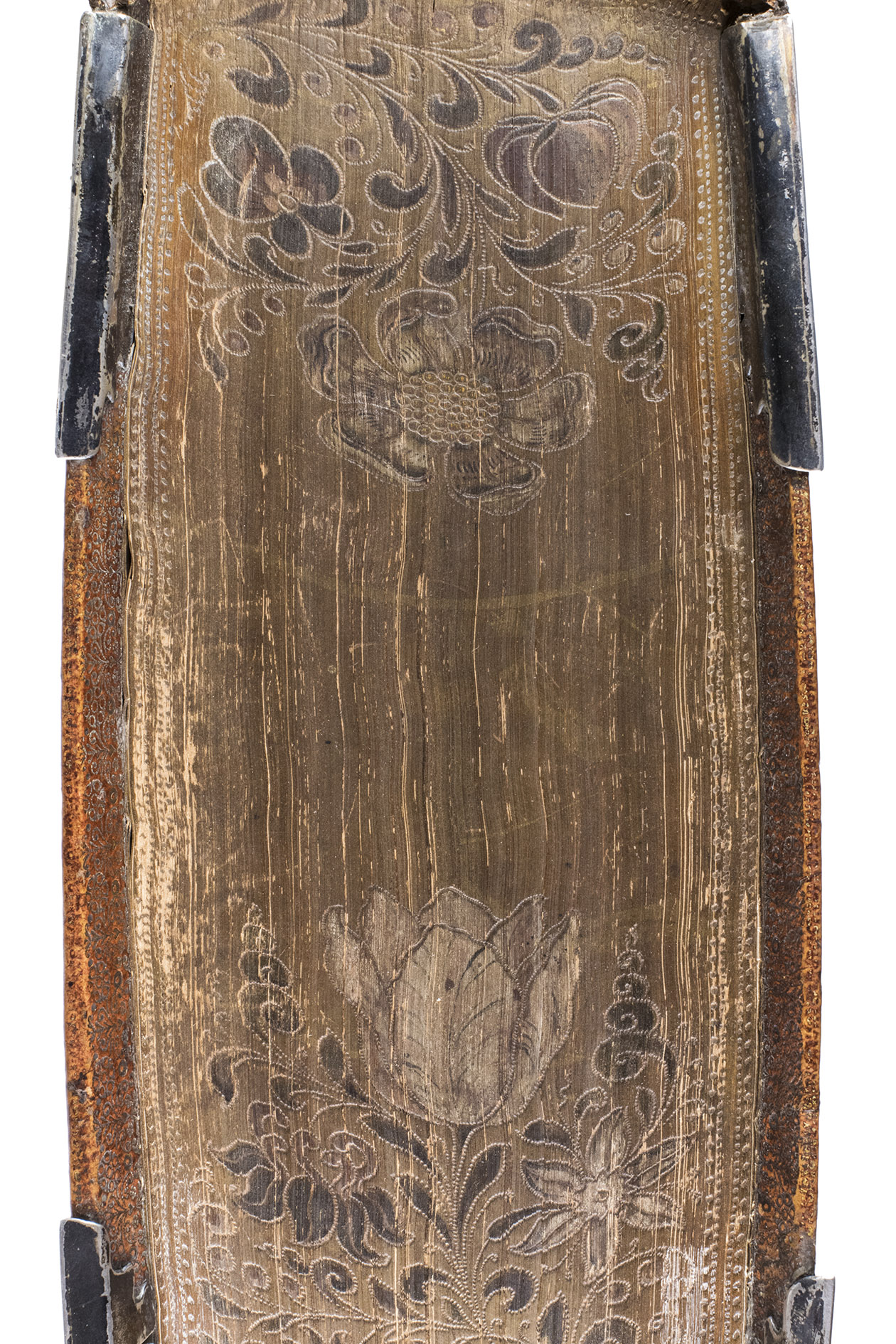[BIBLE - DUTCH].
Biblia, dat is de gantsche Heylige Schrifture, vervattende alle de canonijcke boecken des Ouden en des Nieuwen Testaments.
Including: De boecken genaemt apocryphe ...
Leiden, widow and heirs of Johannes Elzevier, 1663. 3 parts in 1 volume. Large folio (44.5 x 28 cm). With 3 letterpress title-pages (the first in red and black, and each with the same Elzevier woodcut tree device with "non solus"), a complete series of 6 double-page engraved maps (the Nicolaes Visscher maps, 5 published ca. 1657 and including the world map added ca. 1663), without the engraved title-page (as usual). Further with numerous woodcut initials and tailpieces. Contemporary elaborately gold-tooled red morocco over bevelled wooden boards, sewn on 8 supports with corresponding raised bands on the spine, with grand silver fittings (with the hallmarks of an unknown silversmith) dated on the inside of one of the clasps "1665", gold-tooled board edges and turn-ins. Further with gilt, painted, and elaborately gauffered and decorated edges; the fore edge shows the coat-of-arms of Jeremias de Bont with some floral decorations, these floral decorations can also be found on the top and bottom edges. The boards show a very intricate gold-tooled symmetric design of ribbons with small geometric stamps and with ornamental curling stamps - better known as "petit fers" - within the different parts of the bigger pattern. The binding contains 4 ornamental corner pieces on each board and two catch plates (front board) and two hinge plates (back board) connected by two decorated massive silver clasps, engraved on the inside "Ieremias de Bont (top) and "1665" (bottom). [22], "368" [= 370]; [13], "167" [= 168]; [2], 77 ll.
€ 85,000
The first Dutch "States Bible" to be printed in roman type, printed by the famous Leiden printers, publishers and booksellers Elzevier. The present copy in the splendid binding was made for a high official within the Dutch Republic, Jeremias de Bont. His family's coat-of-arms can be found on the gauffered, painted, and gilt fore edge and Jeremias' name is engraved in the inside of the top silver clasp (the bottom one shows a date "Anno 1665"). The "States Bible" is the first officially authorized translation of the Bible into Dutch (the "Statenvertaling"), commissioned during the Synod of Dordrecht (1618-1619). The States General of the United Provinces of the Netherlands were asked to pay for it, hence its name. The translation was completed in 1635 and approved, authorized and published in 1637 in Leiden. For the present 1663 edition, the Elzeviers followed the text of the 1657 revised and corrected edition. In a sense, it could be seen as a revolutionary publication, even though it still is an authorised version of the Bible; the present copy contains the live signature of a Leiden city clerk - as usual - to indicate its authorization. The decision to set the main text in roman type rather than the conventional gothic textura, was unprecedented in such publications and not only contributed to the spread of roman type in Dutch-language printed matter generally (works in Latin were often set in roman more than a century earlier), but also contributed to the prolonged popularity of the authorised translation itself and of the present edition.
The present copy is illustrated with 6 double-page maps published by Nicolaes Visscher; this series includes 5 maps of Jerusalem and the Holy Land published ca. 1657 and 1 world map published ca. 1663 (as usual) all in their first state.
Jeremias de Bont (?-1687) was 17th-century politician in the Dutch Republic. He was a member of the "Vroedschap van Gorinchem" (in/since 1674, city council of Gorinchem, in the present-day province of South Holland), burgomaster in Gorinchem in 1679 and 1681-1683, and member of the Dutch "Raad van State" (Council of State) of Holland on behalf of the city of Gorinchem.
We thank dr. J. Storm van Leeuwen for his in-depth analysis of the present binding. Through his findings we know that the present binding is contemporary to the work (1663) and judging by the style of the decorations possibly produced by a German binder in the Netherlands (Amsterdam or The Hague). In his research, Storm van Leeuwen came across 3 other bindings in the same style and all produced around the 1660s. These bindings cannot be ascribed to a hitherto known 17th-century Dutch bindery, thus - for ease of reference - Storm van Leeuwen named the bindery after the present binding: "De-Bont Binderij".
With the signature of J. van der Werve, a city clerk, below the coat of arms of the city of Leiden on the verso of the first title-page, below the privileges. The binding shows slight signs of wear, browned and foxed throughout, the edges are slightly dust-soiled but still showing the highly detailed decorations. Without the engraved title-page (as usual). Otherwise in good condition, a splendidly bound copy for Jeremias de Bont of the famous Elzevier Dutch States Bible. Bijbel tentoonstelling statenvertaling, Amsterdam 1937, 105; Darlow & Moule II, 3321; Delaveau & Hillard, Bibles imprimées, 1200; Le Long, Boekzaal der Nederduytsche Bybel, p. 821; STCN 840822693; Willems 884; for the maps: Poortman & Augusteijn, Kaarten in Bijbels, 27-pp. 179-185; for Jeremias de Bont and his positions within Gorinchem: C. van Zomeren, Beschryvinge der stadt van Gorinchem en landen van Arkel (Gorinchem, Teunis Horneer, 1755); for the De Bont family: De Nederlandsche Leeuw 40 (1992) cols, 121-122 "Bondt (de)?".
Related Subjects:
















